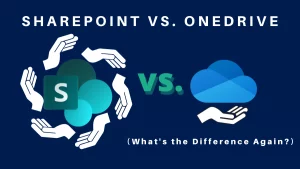The answer is that SharePoint still does a lot of things OneDrive doesn’t.
OneDrive is an as-is, out-of-the-box service. SharePoint requires some development and customization, allowing for more tailored collaboration, but it can do just about anything you may want it to do. Your company may be able to get by with just a OneDrive for Business subscription, but it comes down to what all you need your collaboration platform to do.
But here are some of the main things SharePoint does that OneDrive doesn’t:
Dashboards:
Employees sign in on branded company pages that can feature news, announcements, notices—pretty much whatever you want everyone in the company to see.
Sites: After signing in to the main company dashboard, employees navigate to their department’s site, or even their own site, where they find all the documents they need to work on, along with things like reminders and notifications of co-workers’ availability.
Workflows:
These are automated actions that you can set up that get triggered whenever someone uploads or edits a document. A common example of a workflow is one that automatically sends an email notification to people in other departments if a document or series of edits needs some kind of administrative approval.
Lists:
These are similar to spreadsheets, and they’re used to provide information in areas where they can be accessed by different types of users. A common example is a list of employees with their roles and contact information.
Calendars:
These can be used to schedule meetings, set up notifications and reminders, and help workers keep track of each other’s availability.
Add-ons:
Your SharePoint portal can be further developed by the inclusion of any number of the bolt –on services that are available from Microsoft developers and partners. One such example is the CRM customer management product developed by BP Solutions.

